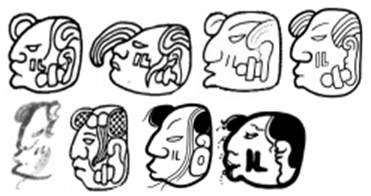



![]()
![]()
K&H.p83.#2 K&L.p23.#3 & K&L.p46.#1 TOK.p23.r1.c3 BMM9.p14.r1.c1 JM.p103.#1 JM.p103.#2
IX / IXIK IX / IXIK IX IX / IXIK IX / IXIK IXIK:ki
· Features:
o The ki as phonetic complement makes the reading IXIK rather than IX (though the absence of the ki does not necessarily mean IX rather than IXIK).
o Features:
§ A sort of “bun” on the top left.
§ Long flowing strands of hair on the right, which IXIIM doesn’t have.
§ “IL”-element on the cheek (optionally bold) on the cheek (though this is not a distinguishing characteristic).
o The same glyph is read IX when in the title of a woman, i.e. “Lady”, and IXIK when it means a woman.
· Do not confuse this with the visually similar IXIIM (“maize”) – distinguishing characteristics:
o IX has one or more strands of hair (representing the long hair of a woman) whereas IXIIM (optionally) has a long, single, bold scroll (representing the sheath leaf of the corn cob) with two or three touching dots (representing maize kernels).
o IX has a simple bracket or oval (optionally cross-hatched) representing a “bun” on the top left whereas IXIIM (optionally) has a “JEWEL”.
o The presence of a ki as an end phonetic complement establishes IXIK.
o Features in common (hence the confusion, also optional):
§ Both can have an “IL”-element on the cheek.
§ Both can have a fancy ear with earspool.
o As none of the distinguishing characteristics are guaranteed to be present, distinguishing IX / IXIK from IXIIM sometimes has to be based on context.
· It is not clear to me whether or not there is a difference between Ix <name> and Ix <name> Ajaw – both forms, with and without Ajaw are common. Conceivably, Ix <name> Ajaw might be a member of the royal family while Ix <name> might be just a distinguished lady, not of the royal family. But the distinction between royal and simply “distinguished” is difficult to make in Classic Maya society, especially as the title Ajaw itself can designate anything from the ruler of a large polity (with vassals) to a member of a “distinguished” family of a smaller vassal town. That is to say, there is a continuous line from “royal” to “noble” to “distinguished” (quite aside from the fact that these are terms in English and hence an attempted etic description anyway).
· Ix sometimes appears with another title, e.g. Ix Aj K’uhuun or Ix <name> Sajal. Opinion is divided as to whether such a lady herself held the office of Aj K’uhuun or Sajal, or whether she was simply the member of a family whose head was an Aj K’uhuun or Sajal:
o In the case of Ix Aj K’uhuun, it seems possible that the lady herself held the office. An example is Ix Yax Paach K’uk’, Ix Aj K’uhuun on MQL Stela 11.
o In the case of Sajal (it being a more “military” title), it seems more likely that the lady herself didn’t hold the office. An example is Ix Chak Xim Sajal, as her brother was sajal at the time.